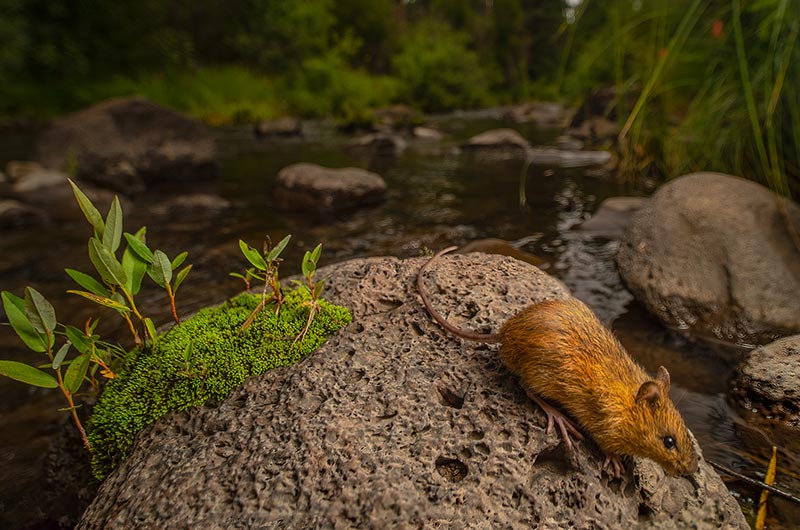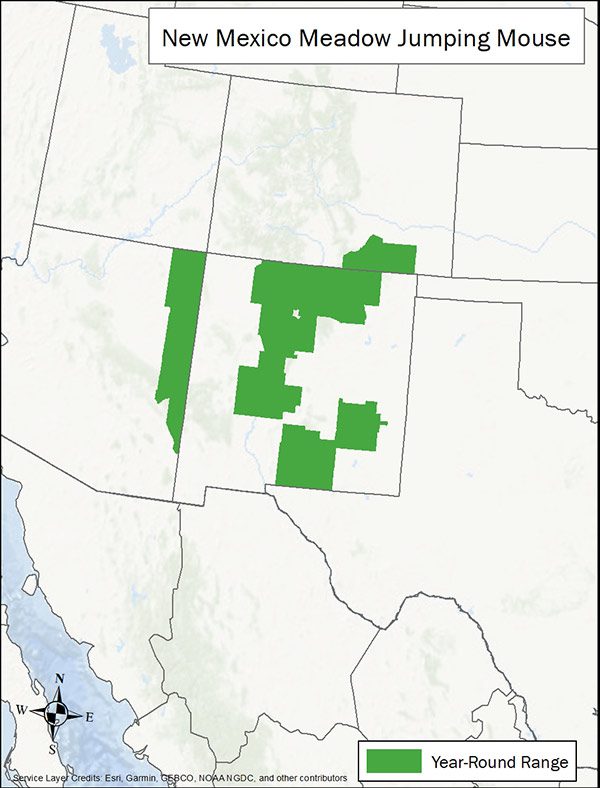LandPKS Learning
Habitat Hub

New Mexico Meadow Jumping Mouse
Beavers significantly impact New Mexico jumping mouse habitat as their dams create slow moving, permanent water sources that encourage diverse and dense vegetation growth that the mice rely on. Beaver activity can also act as a natural fire break.
Zapus hudsonius luteus
Identification
The New Mexico meadow jumping mouse is 7-9 in/18-23 cm long, including a tail which is more than half the total body length. Their coat is grayish brown with yellowish sides and a white belly. Their large back feet help them jump great distances. New Mexico meadow jumping mouse is found in New Mexico, eastern Arizona, and southern Colorado. The historical range was likely larger due to greater riparian habitats, which have been reduced. Now, only a few dozen small, isolated populations are left. The New Mexico meadow jumping mouse is listed as an Endangered species in the U.S.
Observation Tips
New Mexico jumping mice are mostly nocturnal. During the day, they sleep in egg-shaped “day nests” made of woven grass and leaves outside the floodplain less than 33 ft/10 m from streams. They also use adjacent upland areas (<330 ft/100 m from streams) to build nests or burrows to raise young in the summer and hibernate over the winter. Nests are often under trees, shrubs, or even fallen branches on drier soils to reduce the risk of flooding. In July and August, females raise 2-7 young. Jumping mice hibernate for nine months of the year, from mid-September to mid-June.
Interesting Fact
Beavers significantly impact New Mexico jumping mouse habitat as their dams create slow moving, permanent water sources that encourage diverse and dense vegetation growth that the mice rely on. Beaver activity can also act as a natural fire break.
Ideal Habitat
New Mexico jumping mice are riparian obligates, found only in dense, tall, herbaceous sites near permanent water sources. Ideal New Mexico jumping mouse habitat can be found along rivers, streams, wet meadows, irrigation ditches, and river floodplains. Permanent or seasonally present water sources with saturated soils support the tall (>24 in/61 cm), dense herbaceous vegetation (>80%) that New Mexico jumping mice need. Their habitat can also include scrub-shrub areas, usually willow or alder, with an understory of forbs and sedges. Adjacent upland habitat is also critical for nests and hibernation burrows, as well as refuge from flooding. Ideal habitat patches should be less than 656 ft/200 m apart to aid dispersal and promote long-term population health. They can be found up to 8,000 ft/2,438 m in elevation.

Range map provided by NatureServe
Management Activities that Benefit Species – Best Management Practices (BMPs)
Though the New Mexico jumping mouse exists on public lands, private landowners are critical to sustaining populations. When properly managed, riparian areas can provide suitable habitat for the New Mexico jumping mouse. Moderate levels of grazing, leaving tall, dense vegetation, can contribute to conservation efforts. Control livestock grazing using riparian fencing. Use fencing to create lanes in riparian areas to allow livestock access to water while protecting large areas of New Mexico jumping mouse habitat.
Take advantage of available state and federal incentives for protecting and restoring jumping mouse habitat while allowing for livestock activities. Protect high quality riparian habitats from activities that significantly reduce vegetation, divert flowing water, or disturb the ground during the summer. Restore degraded habitat. Promote beaver activity.
Management Activities to Avoid
Avoid habitat degradation and loss, specifically water use and management, including stream modification and wetland draining, large wildfires, and certain recreational activities. Avoid fragmentation of remaining habitat. If possible, reduce or eliminate mowing in occupied habitat during the summer to provide dense vegetation. Avoid eliminating beaver.
Other Species that Benefit from Similar Habitat Management
New Mexico meadow jumping mice are prey for many species, including hawks and owls, weasels, rattlesnakes, and even frogs. Other riparian species, including beavers, also benefit from management activities for New Mexico jumping mice.
Download
Download the New Mexico meadow jumping mouse Factsheet
Other Resources
Colorado Parks & Wildlife. 2020. New Mexico meadow jumping mouse.
NatureServe. 2021. NatureServe Explorer: An online encyclopedia of life [web application]. Version 7.1. NatureServe, Arlington, Virginia. Zapus hudsonius luteus.
U.S. Fish and Wildlife Service. Environmental Online Conservation System (ECOS). New Mexico meadow jumping mouse.
Mobile App | Data Portal | Knowledge Hub | Habitat Hub | Learning Collections | Blog | About | Contact | Support



